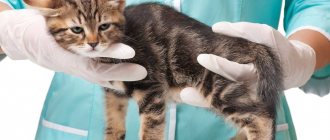External factors
External causes of urolithiasis:
- Nutrition. The predominance of foods high in magnesium, phosphorus, calcium and sodium in the diet increases the risk of developing the disease. Excess protein foods and water with a high content of calcium salts contribute to an increase in the acidity of urine.
- Climatic conditions. A hot climate affects the formation and excretion of urine, diuresis decreases, and urine becomes more concentrated. Improperly organized drinking regime increases the risk of developing urolithiasis.
- Deficiency of retinol and B vitamins.
- Weak animal activity. Breeders overindulge their ward, the predator becomes lazy. Stagnation of uric acid forms in the blood entering the urethral system.
New breeds imported from other countries are more susceptible to the disease.
Diagnostic methods
In case of pathologies of the urinary system, the animal must undergo an ultrasound examination.
Even if the owner knows where the pet’s bladder is and can palpate it himself, it is still recommended to consult a veterinarian. At home, it is possible to determine the presence of a disorder, but it is difficult to establish its cause and choose the right treatment. The specialist needs to check the general condition of the animal and collect a detailed history. To make a diagnosis, a number of manipulations are performed:
- laboratory testing of urine;
- general and biochemical blood test;
- ultrasound examination of all structures of the urinary system;
- bacteriological culture of urine for sensitivity to antibacterial agents;
- cystoscopy if it is impossible to determine the source of the disorder in the bladder by other means.
Internal factors
In cats, 45% of uroliths consist entirely or partially of struvite (a salt of phosphorus and magnesium). Most stones form in sterile urine.
Endogenous causes of ICD:
- Infectious diseases. The formation of struvite uroliths (phosphates) is often associated with urinary tract infections caused by Stafhylococcus and Proteus bacteria. When pathogens enter the body, urease increases the concentration of ammonium in the urine, which leads to an increase in urine pH.
- Idiopathic hypercalcemia is an increased level of calcium in the blood. When plasma is filtered in the glomerular apparatus of the kidneys, calcium accumulates in the form of deposits.
- Obesity. With excess body weight, metabolic processes are disrupted, lipid processes in particular. Your furry friend develops the risk of developing other pathologies that impair diuresis.
- Violation of oxalic acid metabolism. The substance combines with calcium cations to form oxalates. With excessive acid excretion, the poorly soluble salt does not have time to be excreted and accumulates in the form of stones.
- Benign and malignant tumors.
- Developmental defects or acquired anatomical defects.
Be sure to read:
Instructions for use of Ipakitine for cats: composition, analogues, dosage
Pets with a genetic predisposition are at risk.
Possible diseases
Bloody impurities in urine can occur with a hemorrhagic form of the disease in a pet.
Impaired bladder emptying often indicates the development of a serious disease in the urinary system. To a greater extent, cats are diagnosed with an inflammatory reaction in the internal organ, which is known as cystitis. Pathology occurs in several forms indicated in the table:
| View | Peculiarities |
| Idiopathic | A pet is diagnosed when it is impossible to determine the cause of the inflammation. |
| Often, bladder problems are hereditary. | |
| Hemorrhagic | Your cat has bloody urine |
| An advanced course leads to the development of anemia | |
| Occurs in severe forms of urolithiasis | |
| Catarrhal | Inflammation of the bladder affects only the mucous membrane |
| Serous | Accompanied by the release of clear liquid along with urine |
| Purulent | In the cat's urine, the owners observe purulent inclusions of a greenish color with a viscous consistency |
If a cat’s bladder is distended or inflamed, then there may be no clinical picture for a long time. As the disease progresses, the pet's urge to urinate becomes more frequent, pain and constant thirst are possible.
At what age do male cats get urolithiasis?
When diagnosing ICD, one of the main tasks is determining the type of stones. The choice of therapy largely depends on the composition of the uroliths. Veterinarians have compiled statistics regarding the presence of types of stones at different ages of predators.
Struvite is detected in animals from 2 to 7 years of age, and in females more often than in males. Siamese breeds are more at risk. Less commonly - Persian, Russian blue, Abyssinian.
Oxalate uroliths are more often found in animals aged 8-12 years. Struvite stones are usually detected in Persian, Himalayan, and Burmese breeds. Recurrence of oxalate uroliths is a potential problem.
Signs of urolithiasis in cats
Symptoms of the pathology depend on the location of the stones:
- Disruption of the urination process. The presence of sand in the lower urinary tract obstructs the flow of urine.
- Vomiting is caused by ureteral obstruction.
- Pain in the kidneys - the animal is unable to touch the abdomen; it occurs when the kidney capsule is blocked.
- Pain when urinating – the pet often goes to the litter box, meows during the deurination process. Such manifestations are typical for urethral stones.
- The appearance of blood stains in the tray is associated with damage to the ureteral mucosa by microscopic crystals (sand).
- A swollen, dense abdomen is observed with urocystolitis.
Clinical signs of nephroliths may not appear until 2/3 or more of the renal parenchyma is lost.
Symptoms of cystitis in a cat
At the very beginning of the disease, the most frequently recorded symptoms of cystitis in a cat are increased urination, and thirst may increase. The stomach is extremely painful, the pet simply does not give in to hands, but tries to rub against the owner, meow, and attract attention to itself. As you can see, these symptoms are not so easy to immediately notice in cats on your own. And many people confuse them with incipient estrus, urolithiasis, and sometimes even with stress. If you do not understand at this stage that the cat has an inflammatory process, then it will become chronic. But it will be more difficult to cope with it, and relapses are recorded much more often.
Obvious symptoms of cystitis in a cat include:
- Frequent running to the litter box. Sometimes the cat doesn’t even make it to the litter box and pees wherever he feels like it. Therefore, cat owners often notice that their previously litter-trained mustache has begun to empty its bladder in all corners of the apartment, even in the center of the room on the carpet.
- No matter how “small” the cat walks, he meows loudly. He's in a lot of pain. Those who have had a urinary cold at least once know first-hand how wildly painful it is to squeeze out even a drop of urine. Therefore, frequent runs to the tray are accompanied by loud yelling.
- Due to the fact that urine is highly concentrated (since it is retained in the bladder), it darkens. Not just yellow, but maybe deep amber.
- Often with drops of blood. What can cause urine to turn brown? Blood in the urine is a clinical sign of cystitis and many other diseases of the genitourinary system.
- There may be pus in the urine. The smell is "heavy". It’s easy to guess that the cat has problems; just look at what’s going on in the litter box after visiting it. The smell and color of the filler can tell you a lot.
- Body temperature rises. Any inflammation leads to fever. Although the temperature rise may be small, almost unnoticeable. The cat is lethargic.
- The stomach is very painful. It often becomes like a drum. The animal hardly lies on its tummy. And he constantly tosses and turns from side to side.
Medications
The conservative method is used either independently or in combination with the surgical one.
Be sure to read:
Polycystic kidney disease in cats: causes, symptoms, treatment, how long they live with this disease, prevention
Indications for non-surgical therapy:
- the presence of small uroliths and sand that can come out spontaneously;
- stones do not affect the passage of urine;
- chronic infections;
- rehabilitation after surgery;
- prevention of relapses.
The conservative method includes a set of therapies, each of which involves the use of certain groups of drugs.
Symptomatic (painkiller):
- Spasmalin is administered intramuscularly every 8-12 hours for 3-5 days. dosage 1 ml/10 kg weight;
- Atropine sulfate is used subcutaneously, intravenously or intramuscularly once a day in an amount of 0.02-0.05 mg/kg;
- Metamizole sodium is administered intravenously, intramuscularly, subcutaneously every 24 hours at a dosage of 0.3 mg/kg.
Diuretics:
- Urolex is administered orally one hour before meals at a dosage of 3 drops per kg of body weight;
- Furosemide – orally 5 mg/kg.
Urodynamic correctors: Urorek, Terazonin, Phoenixbenzamine. The treatment regimen is determined by the doctor.
Agents that prevent the formation and promote the dissolution of uroliths:
- Urolin Serco is mixed 3-5 drops into the food for a week. The course is repeated after 3 months.
- Rowatinex 1 capsule daily.
Antibiotics are prescribed depending on the pathogen and sensitivity to the drug.
Common kidney and urinary tract diseases in cats
They can be congenital and acquired, as well as acute and chronic. The cause of congenital pathologies is genetic disorders.
Urinary system of cats and cats
Congenital diseases
The most common is amyloidosis, a process associated with metabolic dysfunction; a protein polysaccharide substance accumulates in the kidneys, and polycystic disease develops.
Sometimes cats can suffer from aplasia (the absence of one or two kidneys) or renal dysplasia (abnormal growth of the kidneys).
Acute renal failure
This is a rapidly developing disease, as a result of which the kidneys cease to function. This disease is caused by:
- exposure to toxic substances (antifreeze, aminoglycosides, plants of the lily family);
- infections;
- decreased blood flow to the kidneys as a result of shock, dehydration, heat stroke, anesthesia and surgery, blood loss, or sepsis;
- disturbance of urine outflow.
Among the diseases of the kidneys and urinary system in cats, this disease is life-threatening. Treatment is carried out in a hospital, but animals do not always survive.
If you have any suspicions, your pet should be taken to the veterinarian
Chronic renal failure
This is a gradual process that leads to irreversible changes in the kidneys; they cease to function. This disease develops as a result of toxins entering the body, due to impaired blood supply, inflammation, infections, disorders of the immune system, and polycystic kidney disease.
This is a deadly disease. Her treatment will only alleviate the cat’s condition.
Glomerulonephritis
This is an inflammation of the glomeruli of the kidneys, which occurs with immunological disorders. It can also be a consequence of infections and inflammatory processes in the body, as well as malignant neoplasms. However, the cause of this disease in cats cannot always be determined. Glomerulonephritis itself can cause chronic renal failure.
Over time, symptoms of kidney disease in cats may not be immediately noticed. Then the paws and muzzle begin to swell.
Pyelonephritis
An inflammatory disease that occurs as a result of bacterial damage to the kidneys. The disease most often affects the renal tubules.
Nephrolithiasis (kidney stones)
Stones can form as a result of previous urinary tract infections, hereditary predisposition, poor diet, or after taking certain medications.
The severity of the disease and the manifestation of its symptoms depend on the number, size and shape of the stones.
Cat's position when urinating
Cystitis
It is often called idiopathic, meaning the causes of its occurrence remain unknown. Cystitis is an inflammation of the bladder. As a rule, this diagnosis is made if all other diseases have been excluded.
Urinary tract infections
Bacterial bladder infections are more common in animals over 10 years of age. As a result of infection, the bladder becomes irritated and inflamed, and urological syndrome develops.
Urolithiasis - feline urolithiasis (UCD)
Stones form in the bladder, causing irritation and inflammation. This is one of the most common diseases in cats. The main symptom includes painful and frequent urination. Most often, these formations are removed surgically.
You cannot self-medicate; medications should only be prescribed by a veterinarian.
Causes of kidney and urinary system diseases in cats
Diseases of the urinary system are more common in cats than in other types of domestic animals. Pathologies can develop as a result of impaired water metabolism, especially if the pet eats mainly dry food and has limited access to water.
The structure of the feline genitourinary system also plays a certain role - in cats, the urethra is too long and narrows at the exit. Because of this, the urethra is often clogged, resulting in congestion of the renal structures, and inflammatory processes develop.
Treatment for some diseases can be lengthy
Scientists have established a connection between the development of nephritis, bladder inflammation, and urolithiasis. The main causes of these diseases:
- improper living conditions for the animal;
- incorrectly composed diet;
- frequent hypothermia, the presence of infections;
- general intoxication of the body.
Often the problems are related to malnutrition. If a cat is fed predominantly low-quality dry food, which contains synthetic components and tumor-producing substances, there is a high probability of developing serious pathological conditions.
The accumulation of toxic and carcinogenic substances occurs not only in the kidneys, but also in other organs. This leads to damage to cells and tissues, and then to death.
Kidney failure occurs against the background of the development of malignant neoplasms, injuries, toxic substances entering the body, as well as viral and bacterial infections. The risk of developing pathologies increases with age - older cats are more likely to develop such diseases. Particular attention should be paid to pets over 10 years old. With age, the risk of developing kidney and urinary system diseases doubles.
The occurrence of diseases is influenced by the environment. Their appearance can be caused by severe stress, poisoning with toxic substances (lead, paints, disinfectants), and medications.
To clarify the diagnosis, the doctor will conduct an ultrasound examination
What symptoms accompany these diseases?
It is not always possible to understand from a cat’s behavior that she is sick. Therefore, at the slightest suspicion, you should contact a veterinarian before the disease becomes irreversible. The following symptoms may indicate the development of pathologies:
- difficulty urinating;
- increased frequency of urination;
- the appearance of blood in the urine;
- the animal walks past the tray;
- during urination, the pet begins to scream or meow;
- often licks the genital area.
Among the signs of kidney and urinary tract diseases in cats, the following are noted: the animal becomes lethargic, coordination is impaired, appetite disappears, vomiting appears, and thirst increases.
Factors influencing the development of kidney disease in cats
These stones are found in the kidneys of cats.
Disturbances in the functions of the renal system are caused by the following factors:
- insufficient amount of fluid consumed;
- plenty of salt;
- malnutrition;
- overweight;
- poor conditions - keeping in a cold and damp or, conversely, too hot room, in a draft;
- sedentary lifestyle;
- reluctance to perform natural necessities due to a dirty tray or problems with access to it;
- the presence of infections;
- ingestion of toxic substances into the body;
- genetic predisposition.
Diagnostic tests
For pathologies of the urinary system, a general clinical examination of urine is prescribed. The laboratory examines the physical and chemical properties of the material, as well as conducts microscopic examination. But ultrasound is of particular importance. It allows you to quickly and accurately determine the disease.
Drugs are prescribed depending on the severity of the disease
Treatment methods and prognosis
If you suspect any pathology of the urinary system, you must contact a veterinary clinic as soon as possible. If there are symptoms of kidney disease in cats, timely treatment can save your pet's life. Depending on the diagnosis and prognosis, the animal may be prescribed the following treatment methods:
- medications (uroantiseptics, antibiotics and other drugs);
- therapeutic diet;
- change in drinking regime;
- surgical treatment (in the presence of stones, blockage, tumor or congenital pathology);
- infusion therapy.
If you start to develop diseases of the urinary system, the animal will inevitably experience complications. This can be fatal. Some diseases, such as kidney failure, are considered fatal. Their treatment only helps alleviate the cat's condition.
What medications are used
Antibiotics are prescribed if there is a bacterial infection, for example if a cat is diagnosed with pyelonephritis. Hormonal drugs are prescribed when glomerulonephritis is detected. For various types of pathologies, diuretics and potassium preparations are used.
Medicinal feed as a method of prevention
The medicinal food is selected by the veterinarian
A high-quality food should balance not only proteins, fats and carbohydrates, but also minerals that are part of urinary crystals and stones. We are talking about magnesium, calcium, phosphorus, sodium. The food also affects the acidity of urine. All these factors are taken into account when preparing dietary meals.
The owner organizes the food of the sick animal in accordance with the recommendations of the veterinarian. This is done only after receiving test results and making a diagnosis. If you choose a diet on your own, the disease may worsen.
If you have cystitis, your cat's diet should contain as little salt and protein-containing foods as possible. If the cat eats natural products, then you can feed it cereals, low-fat fermented milk products (1-2 times a week), vegetables, and boiled meat. You can't give fish. For a “dry” diet, special medicated foods are suitable.
In case of kidney failure and other diseases, a cat eating natural products must be given meat, which is the main source of protein. It must first be frozen and then scalded with boiling water. It is allowed to feed offal. Fish should be excluded from the diet.
For cats with diseases of the urinary system there are special lines of dry food. However, you can buy such food only on the recommendation of a veterinarian.
Breeds at risk
Urinary tract diseases can develop in representatives of any breed and at any age. Diseases of the lower urinary tract are rarely found in kittens under one year of age. Most often, pathologies appear around the age of four. In males, blockage of the urethra is more common, which is explained by their anatomical features.
According to statistics from veterinary medicine, urolithiasis most often occurs in Persian and British cats, as well as in Maine Coons, Siamese and Russian Blues. Abyssinian, Somali, Persian and Himalayan breeds are more susceptible to congenital anomalies. CRF develops mainly in older animals, more often in Abyssinian and Persian cats.
Folk remedies
Alternative treatments also provide good results. But their use must be agreed with a doctor.
Recipes:
- Infusion of bird knotweed herb. 100 g of dry herb is poured into 0.5 liters of boiling water and left until it cools completely. Give 2 tbsp. spoons before feeding three times a day.
- To restore the acidity of urine, give 1 tsp. carrot juice half an hour before meals.
- To restore diuresis, parsley juice is added to a bowl of water.
If side symptoms occur, folk remedies are canceled.
What to feed a cat with urolithiasis at home
Organizing proper nutrition is of paramount importance. When selecting a diet, the type of stones is taken into account.
Basic principles of the diet:
- Feed the pet 4-5 times at the same time interval.
- Water is provided filtered or boiled.
- Limit consumption of foods high in calcium (milk, egg whites, salmon).
- If oxalates are detected, by-products (liver, kidneys) are excluded from the diet.
- For struvite, boiled beef, rice, and carrots are recommended.
- If the animal is fed natural food, the products are subjected to heat treatment.
- Vitamin supplements should contain a minimum of calcium.
Be sure to read:
Kidney diseases in cats: types, what affects the appearance, symptoms, diagnosis, how to treat
It is highly recommended that you give your furry friend medicated food.
Surgical treatment of urolithiasis in cats
Surgery is used when conservative therapy is ineffective. indications for surgery:
- The presence of uroliths, the size of which exceeds the diameter of the urethra.
- Stones that are unable to pass on their own.
- ICD is complicated by hematuria.
- Concomitant infectious disease accompanied by high fever.
In veterinary surgical urology, several types of lithotripsy (stone crushing) are used. The choice of method depends on the location and size of the stones.
What to do and how to deal with the problem?
A constantly increased bladder volume requires special attention from cat owners, as this may be the first sign of the development of the disease. Only a veterinarian can select the appropriate treatment for the disease. Some people try to cope with the inflammatory reaction in the cat's bladder using herbal infusions and other medications used at their own discretion. But self-medication of cystitis in pets, as in people, can lead to serious consequences. It is possible to cope with the problem with the help of veterinary drugs indicated in the table, the dosage of which and the duration of administration are chosen by the doctor.
| Drug group | Name |
| Products with antibacterial effects | "Ceftriaxone" |
| "Cefoperazone" | |
| "Levofloxacin" | |
| "Ciprofloxacin" | |
| Uroseptics to suppress infection in the bladder | "Furazolidone" |
| "Furagin" | |
| Antispasmodics and analgesics | "Analgin" |
| "Papaverine" | |
| "No-shpa" | |
| Droppers in case of general intoxication of the cat's body | Ringer's solution |
| Herbal teas with a diuretic effect | "Stop cystitis" |
Veterinarians recommend treating hemorrhagic inflammation of the bladder in cats with the help of special drugs that stop bleeding. The best representative of the group is “Ditsinon”.
Prevention of urolithiasis in cats
The basis of prevention is the organization of proper nutrition. The pet's diet must be balanced. Avoid monotony and overfeeding. Feed is selected carefully, focusing on the health status of the predator.
They monitor the drinking regime and control deurination. Regularly scheduled medical examinations are carried out. To prevent relapses, 2-4 ml of CotErvin are administered daily for a week.











